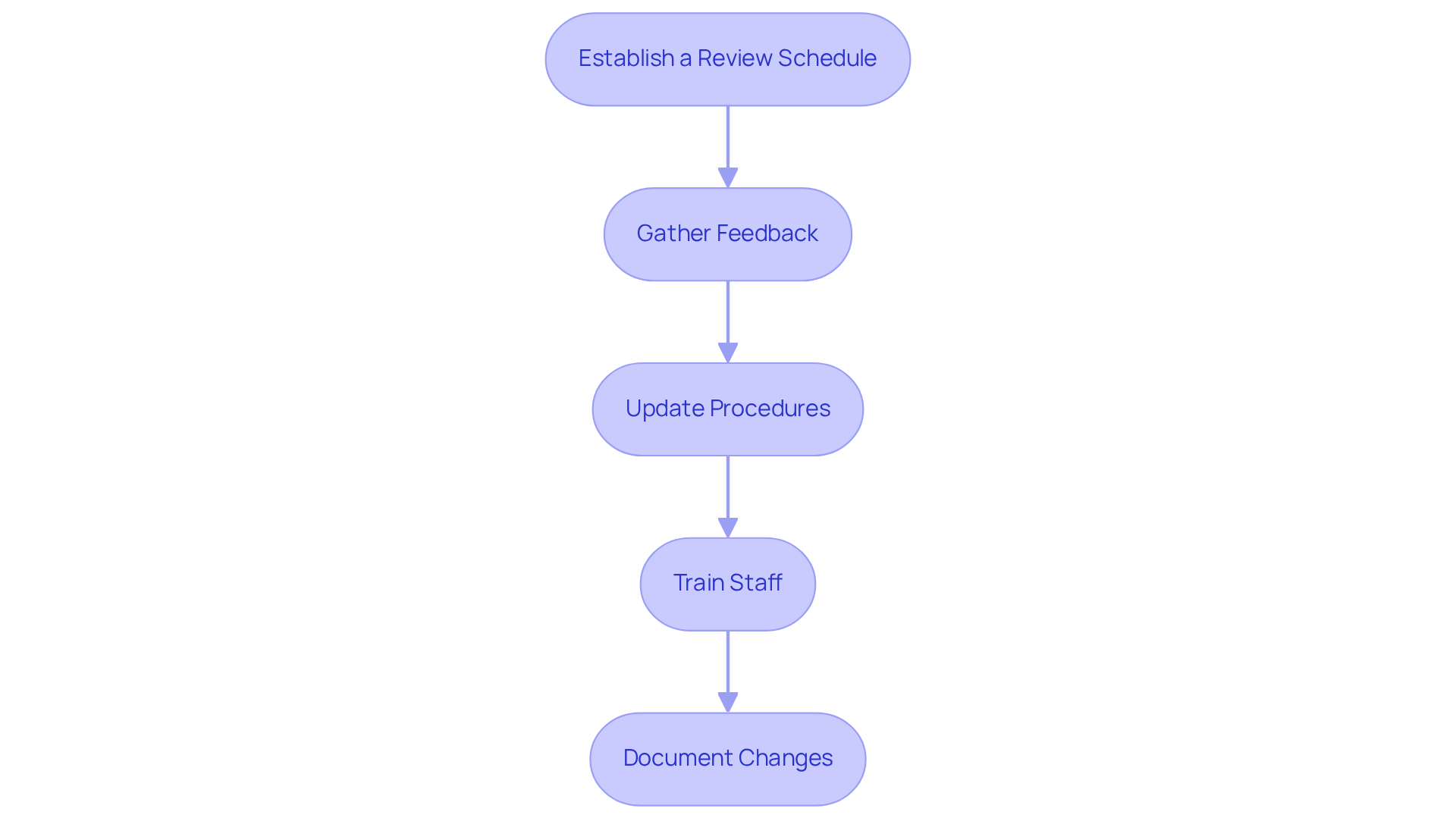
Scaling Businesses with Documentation
|
November 19, 2025
|
Create an Effective SOP for Purchasing in 4 Simple Steps
Key Highlights:
- SOPs for purchasing provide consistency and reduce risks in vendor selection and compliance.
- Clear guidelines in SOPs enhance operational efficiency and minimise errors.
- Key components of a purchasing SOP include a structured template, vendor selection criteria, procurement process guidelines, and compliance measures.
- Stakeholder engagement in SOP development can lead to a 30% higher adoption rate of new protocols.
- Clarity in instructions and the use of visuals are crucial for effective SOP implementation.
- Regular review and updating of SOPs are necessary to maintain relevance and accuracy.
- Gathering user feedback helps identify challenges and improve the SOP effectively.
- Training staff on updated SOPs ensures efficient operations and adherence to procedures.
Introduction
You might be wondering how to create a solid standard operating procedure (SOP) for purchasing. Well, let me tell you, it can be a game-changer for your organization’s procurement strategy! These guidelines not only help streamline operations but also boost compliance and cut down on risks when it comes to vendor selection and financial management.
But here’s the catch: many professionals struggle with drafting and implementing these essential documents. So, what are the key steps to ensure that your SOP not only aligns with your organizational goals but also promotes a culture of efficiency and clarity among your team? Let’s dive into that!
Understand the Purpose of SOPs in Purchasing
You might be wondering why the SOP for purchasing is so important in procurement. Well, think of them as your SOP for purchasing for all those procurement activities. They help ensure that everyone on your team is on the same page by adhering to the SOP for purchasing and following consistent procedures. Plus, they serve as an effective SOP for purchasing to reduce risks related to vendor selection, compliance, and managing finances.
By setting clear guidelines, the SOP for purchasing enhances operational efficiency and minimizes errors. And let’s be honest, who doesn’t want to make training new employees a bit easier? Understanding the purpose of SOPs is really the first step toward creating effective ones that align with your organization’s goals and compliance needs. So, let’s dive into how you can make the most of them!

Identify Key Components of a Purchasing SOP
When you're drafting an SOP for purchasing, you might be wondering what key components to include. Let’s break it down together:
- SOP Template: Think of this as your roadmap. A structured format helps keep things consistent across all SOPs, making it easier to update and train new employees.
- Vendor Selection Criteria: Here’s where it gets interesting! Establishing clear guidelines for evaluating suppliers is crucial. You’ll want to consider factors like quality, cost, reliability, and compliance with Environmental, Social, and Governance (ESG) standards. Did you know that 72% of procurement leaders have stepped up their ESG efforts? It just shows how important sustainable practices are becoming in vendor selection.
- Procurement Process Guidelines: Now, let’s talk about the nitty-gritty. Providing step-by-step instructions for initiating and completing purchases is essential. This includes requisition procedures, approval workflows, and order placement. It ensures everyone on your team knows their roles and responsibilities. Plus, efficient procurement methods can lead to 2-3% in extra yearly savings-who wouldn’t want that?
- Compliance and Risk Management: Finally, let’s not forget about compliance. Outlining procedures to ensure you’re adhering to legal and regulatory requirements is key to minimizing risks in procurement activities. With 57% of businesses reporting better decision-making thanks to risk management technologies, integrating these practices into your SOP can really boost your procurement effectiveness.
By focusing on these elements, you can create an effective SOP for purchasing that not only simplifies acquisition processes but also fosters better supplier relationships and compliance. So, what do you think? Ready to dive into crafting your own SOP?

Draft Your Purchasing SOP
To draft your purchasing SOP, let’s break it down into some simple steps:
-
Gather Input: First off, you’ll want to team up with your stakeholders. Think of it as summoning the wisdom of your documentation! Collect insights on current buying practices and any challenges folks are facing. Did you know that organizations that actively engage stakeholders in the SOP development process see a 30% higher adoption rate of new protocols? Pretty impressive, right?
-
Outline the SOP: Next, create a detailed outline that covers all the key components you identified during your input-gathering phase. This way, you can ensure that every relevant aspect gets the attention it deserves.
-
Write Clear Instructions: Now, let’s talk about clarity. Use straightforward language and clear formatting to describe each step in the buying experience. Throw in some examples where it makes sense - clarity in instructions is key for effective implementation. And hey, there are user guide creation tools out there that can help simplify this task, making your documentation both effective and easy to understand.
-
Include Visuals: Don’t forget about visuals! Flowcharts or diagrams can really help depict intricate procedures, making your SOP easier to grasp. Plus, with the right platform, updating these visuals is a breeze, keeping your documentation relevant and saving you from unnecessary meetings.
-
Review for Clarity: Finally, give your document a good once-over. Make sure it’s free of jargon and that the instructions are straightforward. You want users to follow them without scratching their heads in confusion. With tools like SowFlow, you can quickly update your documentation as needed, boosting productivity and making the acquisition process smoother.
By prioritizing stakeholder input and collaboration, you can develop an SOP for purchasing that not only streamlines operations but also enhances team engagement and compliance. So, what do you think? Ready to tackle your documentation challenges?

Review and Revise Your SOP for Effectiveness
To keep your purchasing SOP effective, let’s break it down into some easy steps:
-
Establish a Review Schedule: You might be wondering how often you should check in on your SOP. Setting regular intervals, like once a year, can help you keep things relevant and accurate. This platform makes it a breeze to access and tweak your documentation right from your browser, so you won’t miss a beat when regulations change.
-
Gather Feedback: Have you thought about asking the folks who actually use the SOP for their thoughts? Actively seeking input can uncover challenges and highlight areas for improvement. The platform has tools that let you gather feedback right there, giving you real-time insights. As Anastasia Masadi, a Product Owner, puts it, 'This platform has been a game changer in the way we document work and deliver to our clients.' I mean, who wants to take screenshots one by one? With this service, I’ve reclaimed precious time in my life!
-
Update Procedures: Now, let’s talk about keeping your SOP fresh. It’s crucial to revise the SOP for purchasing based on the feedback you get and any changes in procurement regulations or company policies. With this system, you can quickly apply updates and ensure everyone’s on the same page with the latest version.
-
Train Staff: You definitely want to make sure everyone’s trained on the updated SOP. The user-friendly interface allows you to whip up training materials and run sessions easily, so your team can get things done efficiently.
-
Document Changes: Lastly, don’t forget to keep a record of any revisions and why they were made. The platform helps you track changes effortlessly, ensuring that the evolution of your SOP is documented and ready for future updates.
By following these steps with SowFlow by your side, you can really boost the effectiveness of your SOPs. This means better productivity and a lot less chaos in your operations!

Conclusion
Creating an effective Standard Operating Procedure (SOP) for purchasing is super important for streamlining procurement processes and keeping things consistent within your team. You might be wondering why a well-crafted SOP matters so much. Well, it not only clarifies expectations and responsibilities but also helps minimize risks and boosts operational efficiency. By setting clear guidelines and a structured approach, organizations can build better relationships with suppliers and stay compliant with regulations.
Now, throughout this article, we’ve highlighted some key components of an effective purchasing SOP. Think about the importance of getting input from stakeholders, having clear instructions, and conducting regular reviews. These elements - like vendor selection criteria, procurement process guidelines, and compliance measures - work together to create a solid framework that drives efficiency. Plus, we can’t forget about incorporating visual aids and feedback mechanisms to make everything clearer and more engaging.
Ultimately, developing a robust SOP for purchasing isn’t just a procedural task; it’s a strategic move that can lead to some serious improvements in procurement practices. So, what can you do? Organizations are encouraged to take action by implementing these steps, regularly reviewing their SOPs, and getting their teams involved in the process. By doing this, you can ensure that your purchasing operations are not only effective but also adaptable to changing needs and regulations. So, let’s get started!
Frequently Asked Questions
What is the purpose of SOPs in purchasing?
The purpose of SOPs in purchasing is to ensure that everyone on the procurement team follows consistent procedures, which helps enhance operational efficiency, minimize errors, and reduce risks related to vendor selection, compliance, and managing finances.
How do SOPs benefit a procurement team?
SOPs benefit a procurement team by providing clear guidelines that keep team members on the same page, improve training for new employees, and help align purchasing activities with the organization’s goals and compliance needs.
Why are SOPs important for new employee training?
SOPs are important for new employee training because they provide a structured framework that simplifies the onboarding process and helps new hires understand the procedures and expectations within the purchasing function.
What risks do SOPs for purchasing help to reduce?
SOPs for purchasing help to reduce risks related to vendor selection, compliance issues, and financial management.
👍
What others are liking
5 Steps to outline your ideal documentation structure
5 MINS READ
Where to start the your journey of mapping out your ideal documentation structure, aligning it with the very heartbeat of your organization?
Defining a winning level of detail in your process
3 MINS READ
What is too much detail, and what is too little? This article described in that winning level detail about what detail is enough.





